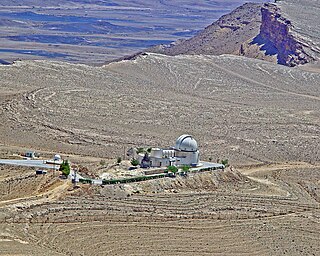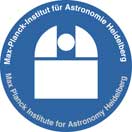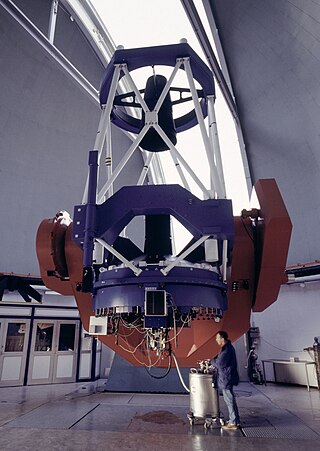
The Large Binocular Telescope (LBT) is an optical telescope for astronomy located on 10,700-foot (3,300 m) Mount Graham, in the Pinaleno Mountains of southeastern Arizona, United States. It is a part of the Mount Graham International Observatory.
The Max Planck Institute for Extraterrestrial Physics is part of the Max Planck Society, located in Garching, near Munich, Germany. In 1991 the Max Planck Institute for Physics and Astrophysics split up into the Max Planck Institute for Extraterrestrial Physics, the Max Planck Institute for Physics and the Max Planck Institute for Astrophysics. The Max Planck Institute for Extraterrestrial Physics was founded as sub-institute in 1963. The scientific activities of the institute are mostly devoted to astrophysics with telescopes orbiting in space. A large amount of the resources are spent for studying black holes in the Milky Way Galaxy and in the remote universe.

La Silla Observatory is an astronomical observatory in Chile with three telescopes built and operated by the European Southern Observatory (ESO). Several other telescopes are located at the site and are partly maintained by ESO. The observatory is one of the largest in the Southern Hemisphere and was the first in Chile to be used by ESO.

Institut de Radioastronomie Millimetrique (IRAM) is an international research institute and Europe's leading center for radio astronomy at millimeter wavelengths. Its mission is to explore the universe, study its origins and its evolution with two of the most advanced radio facilities in the world:

The Florence and George Wise Observatory is an astronomical observatory owned and operated by Tel Aviv University. It is located 5 kilometers west of the town of Mitzpe Ramon in the Negev desert near the edge of the Ramon Crater, and it is the only professional astronomical observatory in Israel.

The Max-Planck-Institut für Astronomie is a research institute of the Max Planck Society (MPG). It is located in Heidelberg, Baden-Württemberg, Germany near the top of the Königstuhl, adjacent to the historic Landessternwarte Heidelberg-Königstuhl astronomical observatory. The institute primarily conducts basic research in the natural sciences in the field of astronomy.

Konkoly Observatory is an astronomical observatory located in Budapest, Hungary is part of the Research Centre for Astronomy and Earth Sciences and belongs to the HUN-REN Magyar Kutatási Hálózat. Konkoly Observatory was founded in 1871 by Hungarian astronomer Miklós Konkoly-Thege (1842–1916) as a private observatory, and was donated to the state in 1899. Konkoly Observatory, officially known as HUN-REN CSFK Konkoly Thege Miklós Csillagászati Intézet in Hungarian, is the largest astronomical research institute in Hungary, and hosts the largest telescopes in the country. The Observatory has more than 60 researchers, a quarter of them are non-Hungarian.

OTS 44 is a free-floating planetary-mass object or brown dwarf located at 550 light-years (170 pc) in the constellation Chamaeleon near the reflection nebula IC 2631. It is among the lowest-mass free-floating substellar objects, with approximately 11.5 times the mass of Jupiter, or approximately 1.1% that of the Sun. Its radius is not very well known and is estimated to be 23–57% that of the Sun.

The Institute of Astronomy of Nicolaus Copernicus University in Toruń, known prior to 1 October 2019 in scientific publications as the Toruń Centre for Astronomy, is an optical and radio observatory located at in Piwnice, about 15 km north of Toruń, Poland. It houses two single-dish antenna telescopes, 32 metres and 15 metres in diameter, as well as the largest Polish optical telescope – 90 cm Schmidt-Cassegrain camera. The facility is operated by the Nicolaus Copernicus University. Also, photometry using 60 cm Cassegrain telescope is made and radio measurements of the Sun at 127 MHz frequency have been recorded on a daily basis since 1958 using a 23 m interferometer.
Daniel Apai is a professor and astrophysicist at The University of Arizona in Tucson, Arizona. He is known for his studies of astrobiology, extrasolar planets, and the formation of planetary systems. He is the principal investigator of the Earths in Other Solar Systems team of NASA's Nexus for Exoplanet System Studies and the Hubble Space Telescope Cloud Atlas Treasury program, and Project EDEN, a large survey for habitable planets in the immediate solar neighborhood. He is leading the Nautilus Space Observatory space telescope concept and co-leading the technology development underpinning it.
Sebastian Florian Hönig is a German astronomer, Professor of Observational & Computational Astrophysics in the astronomy group of the University of Southampton School of Physics & Astronomy, and discoverer of minor planets and comets.

The MPG/ESO telescope is a 2.2-metre f/8.0 (17.6-metre) ground-based telescope at the European Southern Observatory (ESO) in La Silla, Chile. It was built by Zeiss and has been operating since 1984. It was on indefinite loan to the European Southern Observatory from the Max Planck Institute for Astronomy (MPIA). In October 2013 it was returned to the MPIA. Telescope time is shared between MPIA and MPE observing programmes, while the operation and maintenance of the telescope are ESO's responsibility.
HIP 13044 is a red horizontal-branch star about 2,300 light years from Earth in the constellation Fornax. The star is part of the Helmi stream, a former dwarf galaxy that merged with the Milky Way between six and nine billion years ago. As a result, HIP 13044 circles the Galactic Center at a highly irregular orbit with respect to the galactic plane. HIP 13044 is slightly less massive than the Sun, but is approximately seven times its size. The star, which is estimated to be at least nine billion years old, has passed the red-giant phase. The relatively fast rotation of the star may be due to having engulfed one or more planets during the red-giant phase.
Rainer Mauersberger is a German astronomer. His main field of interest is observational molecular spectroscopy of the interstellar matter in galactic and extragalactic star forming regions; millimeter and sub-millimeter astronomy. He is the scientific coordinator of the International Max Planck Research School (IMPRS) for Astronomy and Astrophysics, a collaboration between the Max Planck Institute for Radio Astronomy in Bonn and the Universities of Bonn and Cologne. He teaches as a Privatdozent (lecturer) at Bonn University. He received his PhD from the University of Bonn using the Max Planck Institute for Radio Astronomy Effelsberg 100-m Radio Telescope to measure ammonia throughout the galaxy. The galactic and extragalactic cold interstellar medium remained his main field of investigation while he was working at the Sub-mm Telescope Observatory in Arizona and Pico Veleta Observatory in Granada (Spain), where he served as the station manager for nine years.
Felix Hormuth (born 1975) is a German astronomer, working at the Max Planck Institute for Astronomy (MPIA) until 2016, and a prolific discoverer of minor planets. During his stay at the Calar Alto Observatory in Spain, he has discovered many asteroids, including a Jupiter trojan and two near-Earth objects, such as the 15-meter Amor asteroid 2009 DS36, using MPIA's 1.23-meter reflector telescope.

The Atmospheric Remote-sensing Infrared Exoplanet Large-survey (ARIEL) is a space telescope and the fourth medium-class mission of the European Space Agency's Cosmic Vision programme. The mission is aimed at observing at least 1000 known exoplanets using the transit method, studying and characterising the planets' chemical composition and thermal structures. Compared to the James Webb Space Telescope, ARIEL will be a much smaller telescope and have more observing time available for planet characterisation. ARIEL is expected to be launched in 2029 aboard an Arianespace Ariane 6 together with the Comet Interceptor.

Johann Anton Zensus is a German radio astronomer. He is director at the Max Planck Institute for Radio Astronomy (MPIfR) and honorary professor at the University of Cologne. He is chairman of the collaboration board of the Event Horizon Telescope (EHT). The collaboration announced the first image of a black hole in April 2019.
Ilaria Pascucci is an Italian-American astrophysicist and planetary scientist known for her research on exoplanets, protoplanets, the formation of planets, and protoplanetary disks, using a combination of theory, simulation, and observation. Pascucci is a professor and associate department head in the Lunar and Planetary Laboratory at the University of Arizona.

Laura Kreidberg is an American astronomer who primarily studies exoplanets. Since 2020, she has been director at the Max Planck Institute for Astronomy (MPIA) in Heidelberg, where she is leading the Atmospheric Physics of Exoplanets (APEx) department. She is MPIA's managing director as of January 2024.
Hans Friedrich Elsässer was a German astronomer and founding director of the Max Planck Institute for Astronomy in Heidelberg.












